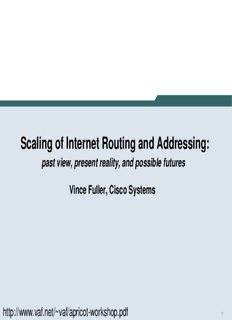
Scaling of Internet Routing and Addressing - APRICOT PDF
Preview Scaling of Internet Routing and Addressing - APRICOT
Scaling of Internet Routing and Addressing: past view, present reality, and possible futures Vince Fuller, Cisco Systems http://www.vaf.net/~vaf/apricotworkshop.pdf 1 Acknowledgements This is not original work and credit is due: • Noel Chiappa for his extensive writings over the years on ID/Locator split • Mike O’Dell for developing GSE/8+8 • Geoff Huston for his ongoing global routing system analysis work (CIDR report, BGP report, etc.) • Jason Schiller and Sven Maduschke for the growth projection section (and Jason for tagteaming to present this at NANOG) • Tony Li for the information on hardware scaling • Marshall Eubanks for finding and projecting the number of businesses (potential multihomers) in the U.S. and the world 222 Agenda • Look at the state growth of routing and addressing on the Internet • Review the history of attempts to accommodate growth • Examine current trends, scaling constraints imposed by hardware/cost limitations, and how the future might look if nothing changes • Explore an alternative approach that might better serve the Internet community 333 Problem statement • There are reasons to believe that current trends in the growth of routing and addressing state on the global Internet may cause difficulty in the long term • The Internet needs an easier, more scalable mechanism for multihoming with traffic engineering • An Internetwide replacement of IPv4 with ipv6 represents a oneinageneration opportunity to either continue current trends or to deploy something truly innovative and sustainable • As currently specified, routing and addressing with ipv6 is not significantly different than with IPv4 – it shares many of the same properties and scaling characteristics 444 A view of routing state growth: 1988 to now From bgp.potaroo.net/cidr/ 555 A brief history of Internet time • Recognition of exponential growth – late 1980s • CLNS as IP replacement – December, 1990 IETF • ROAD group and the “three trucks” – 19911992 • Running out of “classB” network numbers • Explosive growth of the “defaultfree” routing table • Eventual exhaustion of 32bit address space • Two efforts – shortterm vs. longterm • More at “The Long and Winding ROAD” http://rms46.vlsm.org/1/42.html • Supernetting and CIDR – described and proposed in 19921993, deployed starting in 1994 666 Pre and early postCIDR: 1991 1996 From bgp.potaroo.net/cidr/ 777 A brief history of Internet time (cont’d) • IETF “ipng” solicitation – RFC1550, Dec 1993 • Direction and technical criteria for ipng choice – RFC1719 and RFC1726, Dec 1994 • Proliferation of proposals: • TUBA – RFC1347, June 1992 • PIP – RFC1621, RFC1622, May 1994 • CATNIP – RFC1707, October 1994 • SIP – RFC1710, October 1994 • NIMROD – RFC1753, December 1994 • ENCAPS – RFC1955, June 1996 888 Internet boom: 1996 2001 From bgp.potaroo.net/cidr/ 999 A brief history of Internet time (cont’d) • Choice came down to politics, not technical merit • Hard issues deferred in favor of packet header design • Things lost in shuffle…err compromise included: • Variablelength addresses • Decoupling of transport and networklayer addresses and clear separation of endpointid/locator (more later) • Routing aggregation/abstraction • Transparent and easy renumbering • In fairness, these were (and still are) hard problems… but without solving them, longterm scalability is problematic 111000
Description: